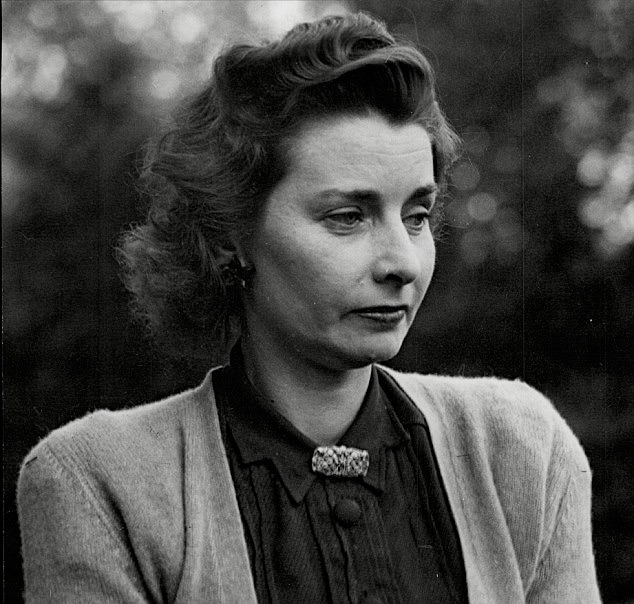Widow of Britain's most-famous wartime flying ace Sir Douglas Bader has died aged 97
The widow of Battle of Britain flying hero Sir Douglas Bader has died, aged 97.
Lady Joan Bader passed away peacefully in her sleep at her care home in Rhayader, South Wales.
She was a former nurse who worked during World War Two and become the second wife of Sir Douglas in 1973, after the pilot had been widowed.

Lady Joan Bader passed away peacefully in her sleep at her care home in Rhayader, South Wales

Joan Bader, pictured, with her grandchild Charley, son of Wendy McCleave, in 1980

Sir Douglas lost both of his legs in an RAF plane crash, while he was performing acrobatic stunts in 1931, but he didn't let it stop him from flying and he rejoined the air force in 1939 to fly with the 19 Squadron's Spitfires
A message on the Douglas Bader Foundation's Facebook page said: 'We are sad to announce Bader Joan Eileen Lady, OBE passed away peacefully on 18th December Wife of Group Captain Sir Douglas Bader.'
It is thought Lady Bader will be cremated in Aberystwyth, North Wales, on January 5.
She leaves three children, Wendy, Michael and Jane, and grandchildren Charley, Tessa, Adam, Russell, Jeannie, Hattie, Jojo, Robin and great grandchild Luna.
Sir Douglas lost both of his legs in an RAF plane crash, while he was performing acrobatic stunts in 1931, but he didn't let it stop him from flying and he rejoined the air force in 1939 to fly with the 19 Squadron's Spitfires.
In 1941, however, he was shot down and captured by the Germans, who treated him with great respect - even allowing the Brits to drop in a new prosthetic leg.
He became such a nuisance for the Germans, who were becoming increasingly annoyed by the number of attempted escapes he made.
Sir Douglas wasn't a free man until the war ended. His bravery was immortalised in the 1956 film Reach for the Sky, starring the late Kenneth More as Sir Douglas.
He died from a heart attack in 1982, aged 72.
Lady Bader spent many years with her husband at their beloved farmhouse in Marlston, near Hermitage, Berkshire.
She also gave much of her time to charities, including Guide Dogs for the Blind and Riding for the Disabled and was awarded an OBE for services to disabled people.

She was a former nurse who worked during World War Two and become the second wife of Sir Douglas in 1973, after the pilot had been widowed

Lady Joan Bader at service for her husband Sir Douglas Bader at the RAF church St Clement Dane

From the moment Sir Douglas Bader's plane crashed in 1931, it appeared he would be lucky to live, let alone fly again

Sir Douglas wasn't a free man until the war ended. His bravery was immortalised in the 1956 film Reach for the Sky, starring the late Kenneth More as Sir Douglas
Lady Bader was also involved in volunteering at the Watermill Theatre in Newbury and also at Bucklebury Horse Trials and was often seen enjoying a drink at her favourite hostelry - the Old Boot Inn in Stanford Dingley - with her friends.
She was a resident at the Crosfield House care home in Rhayader at the time of her death a week before Christmas.
Earlier this year, it was revealed that she suffered a stroke in her former residential home, but no one had taken action, despite the attempts by one nurse, Adeline Dalley, to seek medical treatment.
Only after her daughter Wendy McCleave's intervention was Lady Bader taken to hospital, where doctors told her daughter that she was dehydrated and severely malnourished.
It is thought Lady Bader will be cremated in Aberystwyth, North Wales, on January 5.
She leaves three children, Wendy, Michael and Jane, and grandchildren Charley, Tessa, Adam, Russell, Jeannie, Hattie, Jojo, Robin and great grandchild Luna.
SIR DOUGLAS BADER: THE INSPIRATIONAL SECOND WORLD WAR HERO AND THORN IN THE SIDE OF THE GERMANS

War hero: Sir Douglas Bader
By Sam Tonkin for MailOnline
From the moment Sir Douglas Bader's plane crashed in 1931, it appeared he would be lucky to live, let alone fly again.
While trying low-flying aerobatics his aircraft crashed when the tip of the left wing touched the ground and both his legs were amputated – one above and one below the knee. But he wouldn't be deterred and managed to rejoin the RAF in 1939 when war broke out, flying Spitfires with 19 Squadron.
A hero to most of his men, Bader flew with 222 Squadron ahead of the Dunkirk evacuation. He was then sent to command 242 Squadron, a Hurricane unit that had suffered heavy casualties in the Battle of France.
In 1941 he was shot down and captured in France. German forces treated Bader with great respect. He lost his prosthetic leg when he bailed out and the Germans allowed a new one to be dropped in by the British.
From then came his series of escapes. He tried so many the Germans threatened to take away his legs.
Bader escaped from a hospital by tying together a number of sheets but was betrayed by a hospital worker. After the war, the French authorities sentenced the woman informer to 20 years in prison.
In 1942 he escaped with three others from Stalag Luft III only to be found a few days later - the Germans were so concerned by his attempts they produced a poster describing him and how he walked so the public could spot him if he fled again.
Finally he was sent to Colditz staying there until the end of the war - but he had tried his best to get out before then.